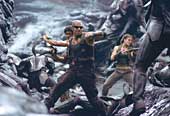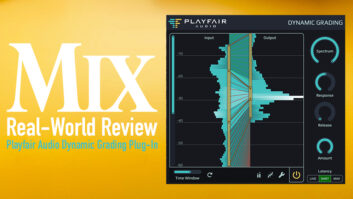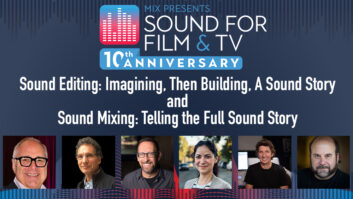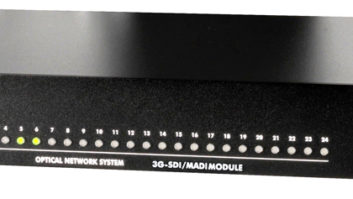

Photo: Joseph Lederer
So it didn’t get the box office hoped for following its debut in early June. But Universal can take solace in the fact that this is just the beginning. The Chronicles of Riddick is a franchise, a dark action/adventure that weaves subplot after intricate subplot into the alternate universes of feature film, anime, games and DVD. Sound design, of course, is crucial to all of its components. It’s a fact: These days, in the brave new world of computer-generated imaging, sound design has to be nimble, quick and more creative than ever. And it has to cover multiple release formats.

Supervising sound editor Scott Gershin in his Soundelux home
Photo: Maureen Droney
“We got CG all the way up to the end, and music was still being scored until the last week. We were busy redesigning in the very last hours,” says a weary Scott Gershin of Soundelux, who served as supervising sound editor and sound designer for the film, creative director and co-supervisor for Dark Fury, the anime, and sound design consultant for Escape From Butcher Bay, the game.
Riddick itself was a long time in the making, and Gershin was brought onboard unusually early in the process. “We usually get involved when post starts and have 16 to 20 weeks for a movie,” he says, “but for Riddick, I ended up on the project for eight months. I’d worked on [director] David Twohy’s last movie, and he invited me to read the script when they were just conceptualizing. They had visuals all over the walls — pictures, sketches, magazine clips — stuff audio people rarely get exposed to.
“Even though I’m a sound designer,” Gershin notes, “it’s always about the story, not just singular sounds. There are occasions when a sound may not be strong by itself, but used in the right context, it becomes perfect. Ultimately, what I’m trying to do is get a reaction from an audience. Plus, in Riddick‘s genre, a lot of the audience are videogamers expecting an E-ticket ride, so we have to rock the room.”
Gershin brought in “wingman” Peter Zinda early on for additional recording and weapons design. Sound designers Jon Title, Ann Scibelli and Bryan Bowen, along with several other editors, were also brought on to handle the frequent CG and editorial updates. Hugh Waddell came onboard to supervise ADR and dialog. Gershin explains, “I broke the show up into categories, with each designer and editor focused on different aspects of the film. Between temp deadlines and CG turnovers, we had numerous one- or two-day turnarounds. We needed to be flexible to support the schedule.”
MUSIC, ANIMALS, MOUTHS
Basically a traditional action film with a sci-fi twist, Riddick is loaded with eerie atmospheres. Sound design took several directions; one of them was musical. “I wanted the starships to have their own personalities rather than just being rumbles,” Gershin relates. “I used guitars and Marshall amps with lots of processing. We also used vintage synths and hip hop/beatbox-type elements. And we definitely explored the sub-frequencies; on the dubbing stage, the joke was that the sound was sometimes 1.5 rather than 5.1. I also used choirs and dissonant chords in different ways to create a vibe, especially for the [evil] Necromonger characters.
“Originally, we’d used a lot of low growling sounds for the Necro ships,” he continues. “But when we heard the music, the design didn’t cut through, so we consulted with composer Graeme Revell and music editor Josh Winget to design each scene with both music and [effects] in mind. I like to do what I call ‘audio focusing’: In scenes not driven by dialog, the goal is, ‘What do we want the audience to focus on at any moment in time?’ Just because you see a big ship in front of you doesn’t mean you need to hear it all the time; something else might be more interesting. A strange thing happens once a steady sound is introduced. You can slowly mix it away so other sounds can be heard and the audience never notices that it’s gone. It’s like weaving. [Dialog mixer] Chris Jenkins, [sound effects mixer] Frankie Montaño and [music mixer] Rick Kline did an amazing job.”

The Riddick audio crew on the Universal Hitchcock stage, from left: music mixer Rick Kline, lead mixer Chris Jenkins, director David Twohy, ADR supervisor Hugh Waddell, re-recording mixer Frankie Montaño and supervising sound editor Scott Gershin
The editorial team spent four months building a library, which Gershin says, “in the end turned out to be a lifesaver.” Several days were spent at the Sherman Oaks, Calif., studio of Rob Arbittier, known for his vintage and modern synthesizer collection. Other days were spent creating effects with guitars, a Vocoder, Native Instruments’ Vokator and plain old mouth noises.
“I’m the voice of Flubber, among other characters and inanimate objects in various movies,” Gershin says with a laugh. “There are things I can do with my voice that I can’t do with anything else. For a lot of the ships, I needed screaming elements and low-end sounds. I didn’t want to do Star Wars-style animals, so I used my voice.”
A pyrotechnic convention in Lake Havasu, Ariz., yielded fireworks fodder. Animals — from leopards to Bengal tigers and wolves — were recorded during feeding time at Frazier Park, located just north of L.A. Gershin also prevailed upon a pilot neighbor for access to a Lear jet hanger, where the crew recorded interiors, alarms and hydraulic systems.
THE STUDIO
The bulk of the sound editorial was done at Soundelux’s Hollywood facility. Gershin’s studio, which he likens to a “mini dubbing stage,” contains some unusual centerpieces: a Roland Octapad, a Light Beam and an Atari Hotz MIDI Translator, each of which he plays like an instrument. “Jimmy Hotz only made 25 of the Translators,” says Gershin. “It has pads with velocity-sensitive control. I can actually play the EQ and outboard gear with MIDI.”
Gershin’s Pro Tools system currently runs on Macintosh OS 9. To preserve favorite plug-ins and VST instruments before upgrading to Pro Tools|HD, there’s also a “virtual outboard rack,” a PC that interfaces via a Sek’d AES/EBU card using Nuendo software to communicate with Pro Tools.
“I recently got rid of my mixer,” he explains. “All my outboard gear goes into Pro Tools and is controlled by a Control|24. I have one 888|24, which goes straight to an [Otari] PicMix and then to the speakers. Three 888s route 24 channels of I/O dedicated to outboard gear, which includes a TC Electronic 6000; a Lexicon 480XL, PCM 80 and 90; an Eventide Orville; and a Waves L2.”
Synths abound: an Oberheim Expander, a Jupiter 6, a Korg Triton, a Pro-1, a DX7, Kurzweil and E-mu samplers, a Virus, a “ton” of Roland modules and a Wavestation. Mic pre’s are ATI and Millennia STT-1 with a Telefunken tube. Other favorite processing includes TC Electronic FireWorx, Waves IR reverb, a Mutator Filter, a Boss VT-1, a Dolby Model 740 Spectral Processor, “everything from Waves — love their stuff, Seratos PNT, “everything from Native Instruments, including Vokator,” Moog Modular V and more.
THE GAME
Escape From Butcher Bay — the galaxy’s most deadly prison — was developed in Sweden by Starbreeze Studios. Gershin and Soundelux were brought in to work with Starbreeze’s team to enhance the game audio and to sonically tie together the opening and closing flashback scenes that reference The Chronicles of Riddick, as well as create a long list of sound design effects for use in game play.
“Part of what’s intriguing about this franchise,” notes Gershin, “is that it’s different stories in the same universe. For the game, David Twohy, Vin Diesel’s Tigon Studios and Vivendi Universal wanted to preserve a sonic landscape with as much Riddick flair as possible. But stylistically, it’s different. There’s also a culture, of course, to video games. Sometimes, gaming people consider film sound designers to be too ‘Hollywood.’ For Butcher Bay, we thought a lot of what Starbreeze had was great. We suggested sounds that we thought would bring something new to the game and also keep to the style of the movie.”

Bryan Celano, lead sound designer for Escape From Butcher Bay
Photo: Justin Langley
Soundelux’s part in the game took approximately three months, according to lead sound designer Bryan Celano. “Because Riddick’s weapons were similar in the game and the movie,” he notes, “we ended up doing a lot of the game weapons using sounds recorded for the film.”
With Xbox and Playstation available in 5.1, game fidelity can be as good as a movie or home DVD. “Because game scenes are rendered on the fly without knowing when or where the player is going to go,” points out Celano, “the sound has to be rendered in real time, too. It helps to know which elements in the room are going to be moving around and which are just going to be ambiences or backgrounds.
“Sound effects and music for interactive projects are usually given a RAM maximum,” he continues. “You create the sounds and in the end, you look at your pile of sounds; what’s low priority needs to get squished down as small as possible. We use spreadsheets to total up the accumulated RAM; if we’re over, we have to cut back on something. Recent game development technology allows multitrack streaming audio, which opens up the limits quite a bit.”
THE ANIME
Dark Fury, by noted animator Peter Chung (The Animatrix: Matriculated, MTV’s Aeon Flux), presents a new vision of the Riddick universe bridging Pitch Black and The Chronicles of Riddick, with Riddick battling bounty hunters and vicious creatures in the slaughter cells of a massive starship.

Soundelux’s sound supervisor Glynna Grimala (left) and Tom Ozanich worked on the anime.
Photo: Dutch Hill
For Dark Fury, sound was created from scratch, with Soundelux’s Glynna Grimala serving as sound supervisor. “Peter [Chung] came in at the initial meeting knowing exactly what he wanted,” says Grimala, “but he was also very open to new ideas.
“We had a lot of conceptual meetings and then, after we saw a rough cut, I started pulling a library together for the designers, creating templates within Pro Tools so that it flowed easily,” she says. “I established a system and then worked with Scott to get him material to comment on. I supervised three other designers, and also cut dialog, supervised Foley and edited. There was also, of course, a lot of ADR that required cleanup and placement.”
Dark Fury‘s plot provides insight and the characters’ back story, but it’s also self-contained. Weapons were familiar; for the fight scenes, sound design pulled materials from the film. But much of the action takes place on a spacecraft that doesn’t exist anywhere except in the anime.
“The ship is rich, high-tech and filled with trapped frozen people,” explains Grimala. “It gave us a chance to do background ambiences within the different rooms and incorporate the concept of tortured souls with whispering and breathing — almost as if the ship is alive.”
The schedule for the 35-minute anime was tight: approximately four weeks for design with two days for the final mix. “What was different about the anime from the film or the game,” comments Grimala, “was that we didn’t have production [sound] to pull from. We really didn’t have anything. We did a ton of Foley because you need movement: footsteps, weaponry, things like that. And, luckily, we have the extensive Soundelux library, as well as access to the library created for Riddick. We also did a lot of our own vocals; for example, one of our designers used my voice combined with his as a base to build on for one of the creatures.”
The two-day mix, by Soundelux’s Tom Ozanich with the assistance of Tony Lamberti and Aaron Levy, was done at Todd-AO Burbank, a member of the Ascent Media family, as is Soundelux. Fortunately, there were three days of predubbing done by Ozanich at Soundelux just prior to the mix.
“If we hadn’t had that ability to work closely together for those predub days,” says Grimala, “I don’t know if that two-day mix would have been possible.”
THOSE ALL-IMPORTANT RATINGS
Pitch Black, the prequel to Chronicles released in 2000, had been saddled with an R rating. This time around, PG-13 was crucial to Universal. “At the very end, we found out we were going to get an R,” says Gershin. Maybe it was Riddick‘s element of realism or its dark nature. We were right on the line, and there was some thought that the audio might be enhancing the violence. So for some key scenes, in addition to strategic picture editing, we had to take out or mix down bone crunches, gooshes, sword slices, big punches and machine guns.
“It was extremely difficult, in some cases, to make the changes. In one scene we called ‘One step, one kill,’ Riddick has to slash his way to the ship hangar. There are gravity guns going, slashing and fighting; it was a big scene. But at the end of the day, we had to mellow it. We got to the point where putting in alternate sounds that were too wimpy might not have had the right impact, so we decided to let the music carry the fight. We ghosted some fight design with animals, Koto drums, weird whooshes and little bits of vocals; it became conceptual.”
THE BIG PICTURE
“With Riddick,” concludes Gershin, “we connected the lines between mediums. We tried to develop a symbiotic thread, while stylistically going with the different media as their own entities. Everyone involved was very proud of, and focused on, their medium: David Twohy, the director of the film; Peter Wanat, producer of the video game; and Peter Chung, the creator and director of the anime. They all have their own ideas, and they’re all wary of the big arm of Hollywood. For me, it is important that each creative producer feels connected, comfortable and unique.”

• Click
here to check out exclusive pics of the field recording and mixing sessions
for Chronicles of Riddick.







